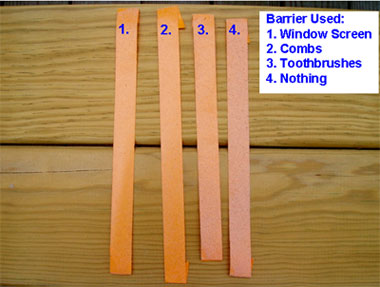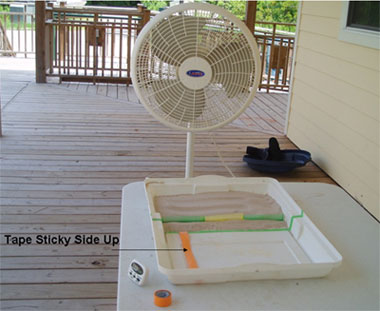Students will compete with other teams to construct the best “barricade” that prevents sediment from spreading in a container during a “hurricane.” The components of the barricade will represent the parts of seagrass. (There is also an alternative activity that is faster and involves less clean-up)
Objective
Students will gain a better understand of the following ecological service provided by underwater grasses: underwater grasses help stabilize sediments.
Materials
- Cookie sheets / flat Rubbermaid containers (or outdoor water table if available)
- Sand
- Large fan
- Masking tape or labeling tape
- Timer
- Assortment of items to build a barrier such as Combs, Window screen, Marbles, Coins, Yarn, Easter Grass, Toothbrushes, etc.
Procedure
- Students should work in groups of about 4-5, following the instructions outlined in the Student Worksheet, below. Each group should be given a tray with a tape line, and a collection of supplies to build their barricade. If you are not able to give each group the same supplies, put the supplies in brown lunch bags and have the groups pick a bag at random.
- Give the groups 10 minutes to build their barricade. They may only use 2 types of the given supplies for their final product, so that they don’t just throw everything on top of the sand.
- When they are ready or when time is up, students will b
 ring their tray with barricade up to the fan station. Anchor a piece of masking tape or lab tape sticky side up on the other side of the line, as shown in the Part 3 Results image in the Lesson Resources. Test each group’s barricade by turning the fan on for 15 seconds. Remove the tape line and compare to all other groups. The group with the least amount of sand stuck to their tape wins! See the Part 3 Results Image (right) for a relative comparison using sample materials. (Since the blowing sand gets all over, you may want to do this part of the experiment outside or somewhere that can be easily vacuumed.)
ring their tray with barricade up to the fan station. Anchor a piece of masking tape or lab tape sticky side up on the other side of the line, as shown in the Part 3 Results image in the Lesson Resources. Test each group’s barricade by turning the fan on for 15 seconds. Remove the tape line and compare to all other groups. The group with the least amount of sand stuck to their tape wins! See the Part 3 Results Image (right) for a relative comparison using sample materials. (Since the blowing sand gets all over, you may want to do this part of the experiment outside or somewhere that can be easily vacuumed.) - Explain that the wind and waves cause the underwater sediment to behave similarly to the sand in their experiment, even though it was not underwater. Seagrasses help protect the shore by trapping and stabilizing sediment and reducing wave energy. The comb (sticking with its teeth up) is similar to the leaves of seagrasses and the screen is similar to the rhizomes. In this case the leaves trap floating sediment particles in the water column and the rhizomes stabilize the sediment already on the surface.
National Science Education Standards
9-12 A. Science as Inquiry
- Abilities necessary to do scientific inquiry
- Understandings about scientific inquiry
9-12 B. Physical Science
- Motions and forces
- Interactions of energy and matter
9-12 C. Life Science
- Matter, energy, and organization in living systems
9-12 E. Science and Technology
- Abilities of technological design
9-12 F. Science in Personal and Social Perspectives
- Personal and community health
- Natural resources; Environmental quality
- Natural and human induced hazards
- Science and technology in local, national, and global challenges
